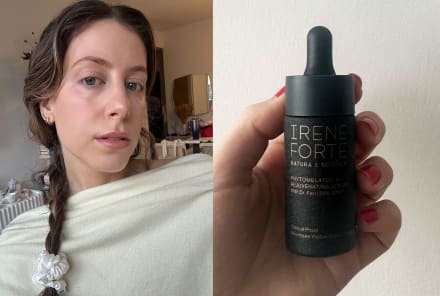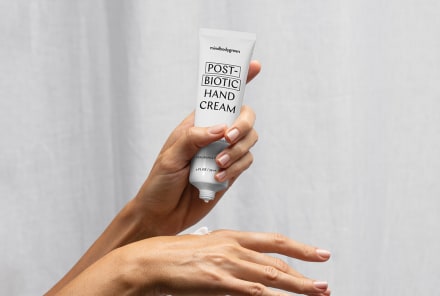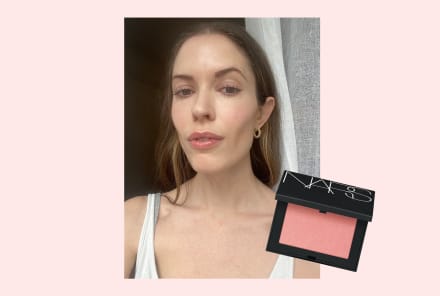Advertisement
How To Hydrate Skin: 13 Derm-Approved Tips To Keep Skin Moisturized


This could probably go without saying, but I'll cover my bases while we're here: You need to moisturize your skin. Without proper hydration, your dermis can become dull, itchy, tight, and inflamed.
Long term, this has less than ideal consequences: Improper hydration can lead to premature aging, developing things like sagging and wrinkles. But it's more than that, too: Moisture plays a vital role in barrier function, one of the organ's most important duties—without it, your skin isn't as protected from external aggressors.
Now that we've gotten that out of the way, here's the good news: It's quite easy to keep your skin hydrated, especially if you do so via multiple avenues. Here, the best and most effective ways to keep your skin hydrated:
How to hydrate skin
There are actually many ways you can keep your skin hydrated—not just a moisturizer.
- Switch to a gentle cleanser
- Use a hydrating toner or essence
- Apply your products on damp skin
- Use humectant serums
- Layer on an emollient cream
- Trap it all in with an occlusive oil
- Take hydration-enhancing supplements
- Use a sleep mask regularly
- Turn the water temperature down
- Invest in a humidifier
- Drink plenty of water
- DIY with kitchen staples
- Eat a balanced diet
Switch to a gentle cleanser
One reason your skin may be feeling dry is because your cleanser is too stripping of your natural oils. It's natural to want an effective cleanser to help you remove makeup, excess oil, or daily debris, but often we can go a bit overboard—the result is dried-out skin post-wash.
Instead, opt for gentle washes that protect your barrier while helping remove particulate matter at the end of the day. If you have really dry skin, you may even consider skipping a wash entirely come morning (this is totally fine, and you can just splash your face with water before applying your daily lotions and tonics).
However, you should never skip the night rinse: You need to wash your face so gunk doesn't sit in your pores causing free radical damage.
"You still need to remove dirt, oils, residues of past skin care products, and air pollutants that may clog pores, cause irritation, and contain free radicals that lead to oxidative damage of the skin cells," says board-certified dermatologist Hadley King, M.D.
Use a hydrating toner or essence
"Unlike the old-school, alcohol-based toners that could be quite drying to the skin, these days they are more often hydrating formulations," King explains about toners.
These essence options are infused with humectants, oils, and other emollients in order to preserve—and promote—the skin's moisture levels.
Aloe, glycerin, hyaluronic acid, and ceramides are some of the hydrating ingredients found in toners that help to hydrate the skin and keep it quenched.
Here are our favorite toners.
Apply your products on damp skin
We consistently tell you to pat your skin dry post-wash or shower—never scrub or pull.
Now, one reason we say this is because it's never good to tug at the skin.
However, we also say this because it leaves skin just a little damp, which can be the ideal setting for hydrating products (particularly humectants) to layer atop of.
"After you cleanse, you want to lock in all that watery goodness," says board-certified dermatologist Angelo Landriscina, M.D. "The humectants in your products, like hyaluronic acid and glycerin, will have an easier time holding on to moisture if you're providing it."
Use humectant serums
On that note: Humectant serums make for wonderful layering options for those with chronically dry skin.
By and large, you should think of serums as your treatment step: So whatever skin care goal you are trying to accomplish, focus on that in this layer. This is because serums are formulated with a higher concentration of actives designed to sit atop fresh skin, and in some cases penetrate the stratum corneum.
So for those whose main goal is moisture, you can achieve that by using serums with humectants like hyaluronic acid and glycerin. Humectants are ingredients that attract and hold water in the skin, helping it stay supple throughout the day.
Hyaluronic acid is perhaps the most famous: "It draws water into the stratum corneum, the top layer of the skin. As a humectant, it gives an immediate improvement in the way the skin looks—less ashy, dry, dull," says holistic dermatologist Cybele Fishman, M.D.
Layer on an emollient cream
However, humectants can't do it alone. Emollients are a class of hydrators that work to restore the skin barrier function by soothing the skin and filling in microcracks in the epidermis with lipids.
If you don't think that you need to focus on your barrier health, think again: Chronically dry, inflammation-prone skin is a dead giveaway that you suffer from a compromised skin barrier.
Emollients include things like...
- Ceramides: "Ceramides are fatty molecules that make up the natural skin barrier and help to retain moisture," elaborates Marisa Garshick, M.D., FAAD. "Specifically, ceramides serve as the glue that helps keep the skin cells together".
- Squalane: "Squalane is a natural oil produced by the sebaceous glands in your skin. It plays a role in skin hydration and barrier protection," says board-certified dermatologist Joshua Zeichner, M.D.
- Colloidal oat: When you finely grind and boil oats, you can extract colloidal material; this gel-like substance has a rather high lipid content (30%, to be exact). "These are the same moisture-trapping molecules that are plentiful in prepubescent skin," says board-certified dermatologist Loretta Ciraldo M.D., FAAD.
- Shea butter: Its moisturizing qualities are tied to the high fatty acid content—and thanks to the types of fatty acids it contains (namely linoleic acid and oleic acid), it tends to be nongreasy and easily absorbed. It's also been shown to seal moisture into the skin and protect the skin barrier1.
Check out our favorite face creams here.
Trap it all in with an occlusive oil
The last step of your moisture-packed layering routine? An oil, which traps in all the hydrators below it. Oils do not have hydrating properties inherently (as they do not contain water), but when used over water-based products, they amplify the other hydrators as they protect them from evaporation.
Take hydration-enhancing supplements
Hydration comes from the inside out as much as it does the outside in. And there are plenty of supplements formulated to keep your skin hydrated, but perhaps one of our favorites is ceramides.
Ceramides are polar lipids, key lipids that are naturally present in our skin cells2. They make up the barrier between the outside environment and our body, locking in moisture and protecting our skin from damage. If you think of the skin barrier as "bricks and mortar," ceramides are part of the mortar holding it all together—50%, in fact3. They play a huge role in keeping your skin moisturized, glowing, and youthful.
And research shows that taking phytoceramides, or plant-derived versions, can help maintain the barrier. In one study, participants with clinically dry skin who took a phytoceramide-rich wheat extract oil for three months saw up to a 35% improvement in skin hydration4. And you might not even have to wait that long for results; in another study, participants saw improved skin hydration after just 15 days5.
Use a sleep mask regularly
Your skin is more permeable at night, which works in two ways.
First, it means that your skin may lose water more easily, as the moisture in your skin evaporates into the air in a phenomenon called transepidermal water loss. But—and this is the exciting part—it also means that actives can penetrate the skin easier, wiggling into the epidermis to do their work.
This is why, among other reasons, derms encourage people to use their most potent actives at night.
Enter: a sleep mask, the ideal treatment for those with dull, dry skin. These pretty products are formulated to infuse your skin with a high dose of ingredients, like antioxidants or fatty acids, to soothe and condition skin.
Turn the temperature down
Using hot water—as in steamy showers and the like—has the incredible ability to strip skin of its natural oils and lipids, thereby stealing from the skin its natural defense system.
Additionally: "Hot water evaporates faster," says board-certified dermatologist Purshiva Patel, M.D., founder of Visha Skincare, and so you don't have as long to trap in the droplets post-wash.
Drink your daily dose of water.
So often we hear how drinking water is the "secret" to some celebrity's perennially good looks. While it is certainly true that most celebrities have a bit more help with skin care thanks to top-tier derms and skin care, there is something to be said for getting your daily intake. No, chugging water isn't going to reverse the clock a decade, but doing so consistently does improve the appearance of the skin. In fact, studies have shown that getting the recommended amount of water for your body increases the dermal layer6, thereby making your skin more hydrated.
Invest in a humidifier
Many derms swear humidifiers are their secret weapon for dealing with dry skin. These little household tools disperse water back into the air—closer to the ideal indoor humidity range of about 40 to 50% (this number can easily fall below 30% during the winter—yikes!)
And in doing so, they are saving you from itchy skin, chapped lips, and thirsty hands in the process. If you don't have the nifty technology on hand, you can try some DIY methods to increase the humidity in your home.
DIY with kitchen staples.
If your dryness issues aren't always of the chronic kind—and thus you're not interested in reinventing the routine wheel—you can toss together some perfectly good DIY hydrators right from your kitchen staples.
Skin feeling a little tight at the moment? Don't worry; these aloe vera masks will soothe them ASAP. Need to soothe and balance irritated skin? This yogurt and honey option will do the trick. Or just looking to infuse skin with some fatty acids and antioxidants? An avocado mask is ideal.
Check out our favorite DIY masks.
Eat a balanced diet
If you want moisturized, plump skin, you should be mindful that you are eating water-dense, high-fat, antioxidant-rich, hydrating foods known for their complexion-changing properties.
These, it turns out, are actually easy to come by—many might already be in our diet (things like leafy greens and vibrant fruits). But if you are feeling a bit on the drier side of late, consider upping your intake.
The takeaway
Moisturization is the foundation for healthy skin. But keeping your skin hydrated doesn't need to be complicated—in fact, with the right skin care steps and lifestyle habits, it's shockingly easy. Once you've gotten the basics down, you can learn how to properly exfoliate.
6 Sources
Watch Next
Enjoy some of our favorite clips from classes
Enjoy some of our favorite clips from classes
What Is Meditation?
Mindfulness/Spirituality | Light Watkins
Box Breathing
Mindfulness/Spirituality | Gwen Dittmar
What Breathwork Can Address
Mindfulness/Spirituality | Gwen Dittmar
The 8 Limbs of Yoga - What is Asana?
Yoga | Caley Alyssa
Two Standing Postures to Open Up Tight Hips
Yoga | Caley Alyssa
How Plants Can Optimize Athletic Performance
Nutrition | Rich Roll
What to Eat Before a Workout
Nutrition | Rich Roll
How Ayurveda Helps Us Navigate Modern Life
Nutrition | Sahara Rose
Messages About Love & Relationships
Love & Relationships | Esther Perel
Love Languages
Love & Relationships | Esther Perel

















